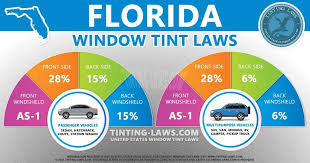Introduction
Tinted windows are a popular vehicle upgrade in Florida, offering benefits like reduced heat, UV protection, and added privacy. However, Florida has specific window tint laws designed to ensure safety and visibility for both drivers and law enforcement. Whether you’re a Florida resident or just visiting, understanding Florida tint laws is essential to avoid fines and stay within legal guidelines. This article provides a clear and comprehensive overview of Florida’s window tint regulations to help drivers make informed decisions.
Legal Tint Limits in Florida
Florida law defines legal tint levels based on Visible Light Transmission (VLT%), which refers to the percentage of light allowed through the window. The lower the VLT%, the darker the tint. Florida’s tint laws vary depending on the window location:
- Front Side Windows: Must allow more than 28% of light in.
- Back Side Windows: Must allow more than 15% of light in for sedans and 6% for SUVs and vans.
- Rear Window: Must allow more than 15% of light in for sedans and 6% for SUVs and vans.
- Windshield: Non-reflective tint is allowed above the manufacturer’s AS-1 line.
These laws are designed to strike a balance between aesthetic preference and road safety.
Reflectivity and Tint Colors
In addition to darkness, Florida also regulates tint reflectivity to prevent glare and visibility issues. The law states:
- Front Side Windows: Must not be more than 25% reflective.
- Back Side Windows: Must not be more than 35% reflective.
Highly reflective or mirrored tints are not permitted, as they can impair visibility and distract other drivers. Florida also prohibits certain tint colors, such as red, blue, or amber, especially on the front windshield and front side windows.
Medical Exemptions for Tint
Florida offers medical exemptions for individuals with conditions that require additional UV protection, such as lupus, photosensitivity, or other skin disorders. To qualify, drivers must obtain a certificate from the Florida Department of Highway Safety and Motor Vehicles (DHSMV). This exemption allows for darker tint than normally permitted, as long as the driver carries proper documentation while operating the vehicle.
Penalties for Non-Compliance
Failing to comply with Florida’s tint laws can result in non-criminal traffic violations, typically handled as fix-it tickets. First-time offenders may face fines or be asked to remove the illegal tint. Repeat violations or continued non-compliance can lead to higher penalties. It’s also worth noting that illegal tint may affect your vehicle inspection or insurance in certain cases.
Tips for Staying Compliant
To avoid issues, always consult a reputable tinting professional who understands Florida laws. Many shops use tint meters to ensure installations meet legal standards. It’s also a good idea to request a window tint compliance certificate, which can be shown to law enforcement if needed.
Conclusion
Florida tint laws are designed to protect drivers, passengers, and law enforcement while still allowing for personal customization. By knowing the legal limits, understanding exemptions, and working with licensed professionals, drivers can enjoy the benefits of tinted windows without risking fines or violations. Whether you’re tinting for style, comfort, or protection, staying informed is the key to staying legal on Florida’s roads.



